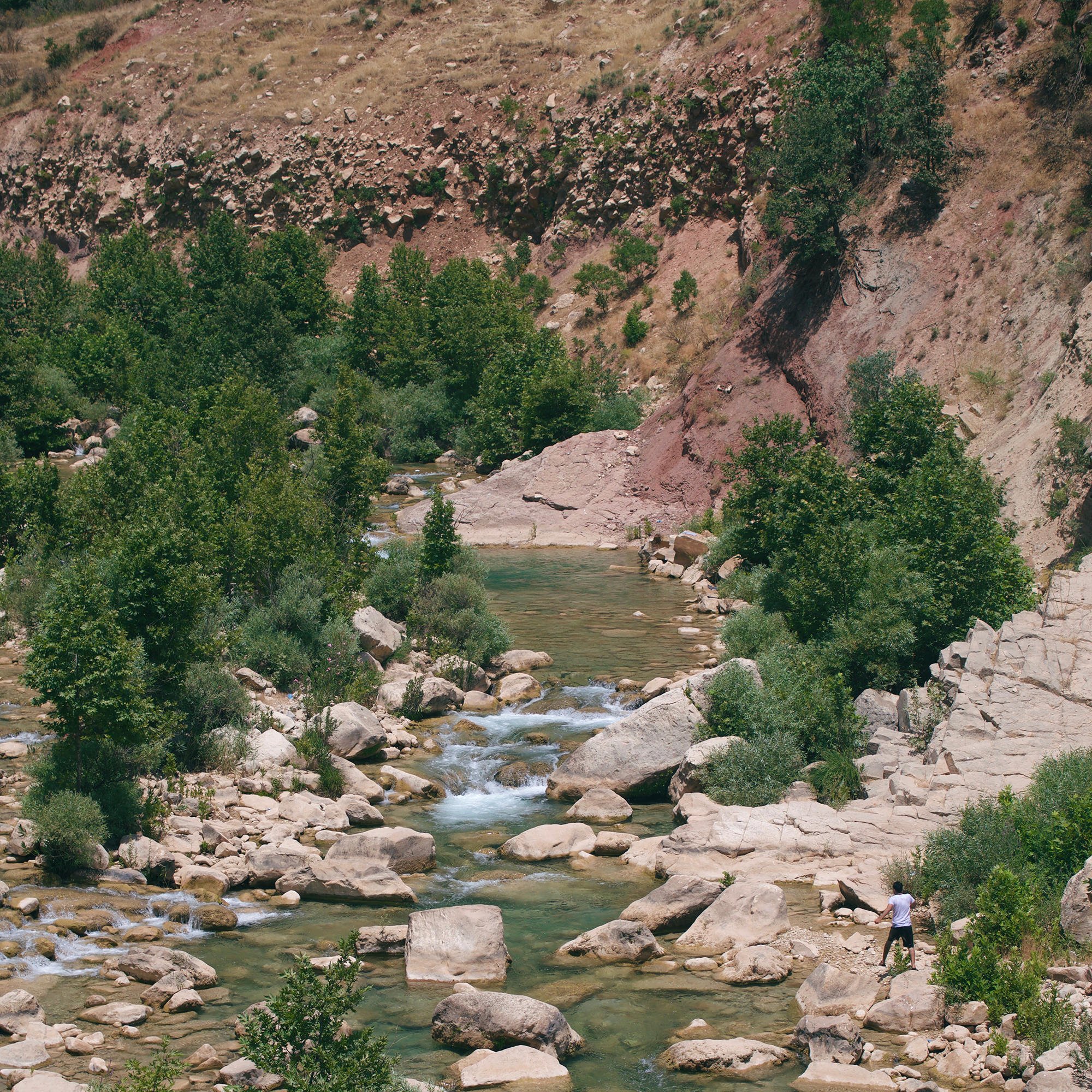The Vanishing Breadbasket
Italy’s Po Valley is drying up. Who will feed the country now?
JUNE 27, 2023
IMAGE: This Copernicus Sentinel-2 animation shows a part of the Po Valley, near Piacenza, and reveals how the river significantly shrunk between June 2020 and June 2022. (via Wikimedia under ESA, CC BY-SA IGO 3.0. Contains modified Copernicus Sentinel data 2020-22)
In 2022, a number of sunken curiosities began to emerge from the Po River, which runs from the French-Italian Alps and carves eastward across northern Italy, through Turin, just south of Milan and Bergamo, before reaching its terminus outside of Venice, in the Adriatic Sea. Near the village of Gualtieri, a barge sunk by the Allies in World War II appeared thanks to the lowered water; near Mantua, a Nazi military vehicle revealed itself in the river; in Piedmont, an ancient hamlet breached the waterline. These sudden reappearances were side effects of the worst drought to hit Italy in 70 years. It significantly lowered water levels throughout the Po River, in some areas by up to 26 feet.
In the last several years, Italy has become belatedly yet acutely aware of the existential threat that climate change poses to the nation. The Po Valley is a crucial economic area for Italy, supplying water to agricultural and commercial industries across the northern regions of Piedmont, Lombardy, Emilia-Romagna and Veneto, which together constitute one of the most important agricultural zones in Europe. The European Union’s Joint Research Centre said last year’s drought raised “concerns on water supply for human use.” The director of the Po Delta drainage consortium warned of “permanent damage” to the basin, as well as to the industries that it supports, which include wine, agriculture, wood, defense and tourism. Each one is critical to Italy’s livelihood, as well as to the idea of Italy itself, and this year’s drought is shaping up to be as bad as last year’s, if not worse.
What could have been a blessing for the northern provinces, home to a significant chunk of the Italian agricultural industry of the Italian agricultural industry, turned into something more akin to damnation.
Yet domestic political turmoil has precluded serious discussions and preparations for dealing with the changing climate. Water evaporation and rising sea levels plague the country, and the nation’s precarious relationship with water has only worsened after the government changed hands last year. In October, the newly-elected Italian Prime Minister Giorgia Meloni called an EU deal to reach climate neutrality targets “climate fundamentalism” and said that a green transition was “not the best solution from an environmental standpoint.” In Venice, where the acqua alta floods city walkways, the government installed inflatable barriers to protect the city’s canals. Political leadership often seems to be in a state of denial. The country’s right-leaning politicians blame climate change on overpopulation and “unwanted foreigners,” according to the International Federation for Human Rights. In August, the Italian minister of ecological transition said, “We hope that the drought is a one-off occurrence.”
But water levels have been declining for years. In 2017, the baroque fountains of Rome were shut off, as were the 100 fountains surrounding the Vatican. Spigots from sidewalk drinking fountains often run at a trickle.
For the past several months, water levels along the Po have been unseasonably low, reaching levels usually seen only in the summer. Management of the river falls to several disconnected regional authorities, all of which exert varying degrees of oversight and do not always coordinate their efforts. “Nothing has changed since 2022,” Luca Mercalli, the president of the Italian Meteorological Society, told The Guardian this spring. “We are still in a situation of deficit.” He said spring rainfall was “the last hope” to avoid a reprise of 2022, but that hope did not materialize. When rain did arrive, it flooded towns and killed residents. In late May, an exceptional series of storms hit the north of Italy. Eight people were killed and more than 38,000 displaced by water surges and landslides. The havoc was largely attributed to the drought: The earth had been dry for so long that it could not fully absorb the rainfall. What could have been a blessing for the northern provinces, home to a significant chunk of the Italian agricultural industry of the Italian agricultural industry, turned into something more akin to damnation.
The Po Valley is a breadbasket for Italy and the EU. Rice, wheat, tomatoes, maize, Parmesan cheese, milk and hams are produced across the region. Last year, some of the farms along the banks of the Po — including both family-owned and commercial operations — began artificially irrigating their fields and feed lots for the first time. Regional specialties like Parma ham and Scardovari mussels, cultivated in the briny lagoons around the Po River delta, are “protected designation of origin” food items, which can’t be produced anywhere else. The low-lying marsh farmers in Pancalieri grow half of Italian mint, much of which is sold to nearby Ferrero, the confectionery company that produces Tic Tacs.
“From now on, we can no longer ignore it,” Simone Minelli, the owner of a small dairy farm along the Po, told The Dial in February. “I live on the Po, and I’ve never seen it in such difficulty. It’s raining in Piedmont, water falls, it gains strength. But in an instant it’s already dry.”
Minelli, a Parmesan maker in the town of Mantova, depends on his 300 cattle to keep his business going. He is part of the agricultural engine of northern Italy, which produces 35 percent of the nation’s food products. By July of last year, the sector had lost $6.6 billion in revenue. The region produces 40 percent of the gross domestic product and consumes nearly half of national energy sources.
The Po provides not only sustenance (nutritional and moral) to its residents, but also light and energy. Power plants situated along the banks of the river rely on its flow both to generate hydroelectric energy and to cool off heavy machinery. Forty-eight percent of Italian hydroelectric production derives from roughly 890 plants in the Po Valley, with 31 percent of the nation’s thermoelectric energy sourced from 400 additional plants across the area. When snow and rain don’t fall, turbines can’t turn. Because of low water levels, one hydroelectric plant shut down, sending energy producers looking for alternatives. (The country has no nuclear power plants and very few coal-fired stations.) Sometimes that means gas, increasing carbon dioxide output, increasing the amount of harmful CO2 retained by vegetation fed to Minelli’s cattle.
Massimo Giordana — an independent producer in Vigevano, a town outside Milan — grows lettuce, peppers, zucchini, fennel and a variety of fruits. “[The drought] exists because it rains less, but it is also a question of management,” he said. “It’s not handled well. We are not part of any consortium. They, [the basin authorities,] cannot find agreements to distribute the water well. There is always one who takes more than what he needs.”
Water management was overseen by local authorities until 1989, when the Po River Basin Authority was first established. Since then, new laws have modified the management every few years, creating a confusing tangle of bureaucratic committees.
So far, national efforts to manage the drought have been largely hampered by domestic corruption.
“The Po crosses four Italian regions, and flows through 13 provinces, so it is obvious that its management must take into account the needs of each reality,” said Massimo Battisti, deputy director of Confagricoltura Mantova, an agricultural trade union along the Po. The federal government recently created yet another oversight committee, chaired by a man named Nicola Dell’Acqua, to manage and discuss drought issues, adding another pathway in the warren of the nation’s water management system. But some believe a return to an even more localized management is essential to the basin’s survival.
“The fact that it’s so decentralized as a country — that every little commune, provincia, regione has their own organization and rules — that’s the key,” said Tobias Jones, who lives in Parma in the Po River Basin and is the author of The Po: An Elegy for Italy’s Longest River. “Almost half of the water taken is wasted along the water network, before arriving at its destination.”
If there was a way to conserve water and farm with less, then perhaps the management would be made irrelevant. So far, national efforts to manage the drought have been largely hampered by domestic corruption. In 2019, the agricultural sector of Italy was roiled by a $65 billion EU subsidy system that was intended to support farmers and prop up rural communities but instead enriched a powerful few.
Giulia Villani — an agricultural meteorologist at the Climate Observatory in the Emilia-Romagna region, where the Po fuels Lambrusco and Parmesan production — manages a team that uses computer modeling to forecast long-term weather patterns and irrigation needs. Such data could limit water waste in irrigation canals while providing designs for new long-term water storage, such as wells, that could take advantage of moments when rain and water are abundant. “Adaptation has to be the focus for agriculture, Villani said. She described efforts to look at produce that demands a high amount of water, such as kiwi fruit, and find alternatives that rely on less water and grow in shorter seasons, such as strawberries.
“One of the things we need to do is understand the sustainability of these types of crops in these areas,” Villani said. “We have to understand that the bigger drought years that we are observing now will be the norm.”
✺
In the meantime, farmers along the Po are taking matters into their own hands, repairing the river basin’s aging infrastructure to get their crops the water they need.
“We are working on reclaiming resources,” said Minelli, the Parmesan maker from Mantova. “Those channels that are made of concrete, where cracks from settling over time have appeared, we are using resins to close them.” Broken infrastructure like those concrete irrigation canals fed by the Po, he says, loses half of the water it carries.
Others have introduced new technology, like drip irrigation and sprinkler systems, to help their farms survive. Gianangelo Pastornio, who oversees a melon and vegetable farm in Rivalta Bormida, near Genoa, said that even these advances constitute “the bare minimum.” “Flow irrigation we abandoned 20 years ago,” he said. “It is no longer good because it uses too much water.”
Giovanni Fasciola operates a farm in Moncrivello, outside Turin, that produces seasonal vegetables, grains and wheat from which he makes fresh pasta to sell at local farmers markets. “I am severely penalized [by the drought],” he said. “And then I realized, for five, six, seven years it rained a lot, then it didn’t rain. There have always been cyclical moments.”
As farmers find new ways to eke out the same amount of crops with less water, some have reverted to time-tested techniques. “It was necessary at first to think of alternatives, but unfortunately we haven’t budgeted for new technology,” said Ornella Tonso, a farmer in Montalenghe, outside Turin, who produces strawberries and a variety of Piedmont fruits. “Now we resort to drawing water from the well.”
Until the rains arrive, Tonso and the other producers remain in a precarious position.
“When there is no water,” Tonso said, “there is no saint who can save us.”



